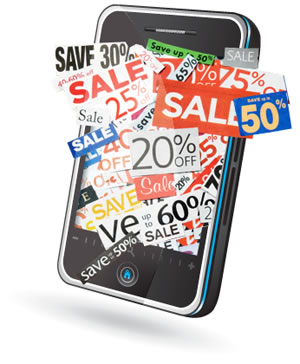How should retailers react to the Socially Comparison and Savings Apps?!
High unemployment, higher fuel costs, drops in credit, tumbling home prices, job market insecurity are amongst the several economic factors has translated into less than stellar sales for most retailers as they enter into their third quarter. Now retailers have a new “friendenemy” in the realms of consumer intelligence, “Social Savings Applications”, which could help consumers save billions of dollars in aggregate. But is consumer savings a good thing for retailers? Moreover, how should retailers respond to social and mobile coupons?
Though less than 5% of consumers use social and mobile shopping applications to compare small ticket items, as opposed to 30%+ that utilize internet search to price big ticket items, retailers must be made aware that this small percentage has a very high influence within their localized social communities. As an example, Margret, a stay at home mom, communicates daily with other moms within her community. Unlike the average social sphere butterfly having 50-75 social connections that updates their social statues 1-2 times a week, Margret has 135 friends, all active, and socially posts 1-4 times daily. Moreover, her social community has approximately the same following, activity, and shopping habits. So in when Margret shares here shopping experience, she is sharing with her 135 friends times 134 friends of friends, equating to 18,000 socially conscience shoppers. So in essence, a 5% usage, could essentially equate to a 20%+ net brand effect in consumer spending on a localized level.
Outside of the socially conscience, hardcore saver, there are folks like myself that are connivance shoppers. We are in the right place, at the right time, and if I can find a good deal somewhere, I will most likely be back again. A quick and dirty example of such a retail outing, I went to Kmart yesterday, not because I am an avid Kmart shopper, but moreover, I ran out of my favorite workout nutraceutical, Whey Protein, and happened to be passing a Kmart. First of all, as a guy I am genetically wired to ignore most coupons and if I want something, I have an innate need to satisfy my cravings. So I journeyed to Kmart to quench my craving. I found my item, though it seemed a little pricey at $27.99.
I’m not one to round pennies, but I don’t want to fell I am getting a bad deal either. So, I pulled out my phone and scanned the bar code using a price comparison application called “Shop Savvy”, though there are literally hundreds of these apps currently online. What I discovered is that Kmart was about 60% more expensive than approximately 15 other local retailers.
Ok, I was a little miffed, but I figured Kmart’s customer service would match the price, right?! To my dismay customer service could do absolutely nothing, and in the words of Kmart’s customer service manager, “I wish I could do something, but management doesn’t listen to us, it’s out of my hands, the price is the price.” Yet, to my surprise, she then picked up her phone and texted her gym friend and asked where she found the best deals for the brand of protein that I desired to purchase”. In a matter of seconds a response came back that was even cheaper than what I found using my social app, though my shopping app did set the bar for savings.
The end result, I saved 75% off of Kmart’s price. I got my Whey Protein; I scanned the bar code and updated the price so other local shoppers can find the same great deal I did.
The lesson for retailers everywhere:
1) Know what you consumers want. Know the hot items per category.
2) LISTEN to the social sphere, what are people saying about your brand and engage both good and bad experiences. Especially do this prior to bad experiences gain a social following. I’ll write a few posts on social listing and engagement next week.
3) If you don’t have the items and your competitor does, either get the items, or know who does so you can refer your customer. It’s not the ideal scenario, but it does show that you are karmatically working in their best interests.
4) Price your competition’s popular products or services items weekly. You don’t need to always have the best price, just a comparable one.
5) Don’t cut costs in customer service or sales support. Nothing makes me want to shop the competition more than a bad experience.
6) Update social shopping applications with the items and prices that are best or most comparable in the market place. Influencer shoppers like Margret will bring her friends and friends or friends.
In conclusion, immersion in social savings applications early could grow your brand and consumer loyalty quickly. Just as many retailers ignored the internet and social media in the beginning, social savings applications as the former are here to stay. Retailers that ignore social shopping apps do so at their demise.
If you want more information on how you can socially engage your customers via couponing, shopping loyalty programs, and social media, feel free to contact me.




Recent Comments